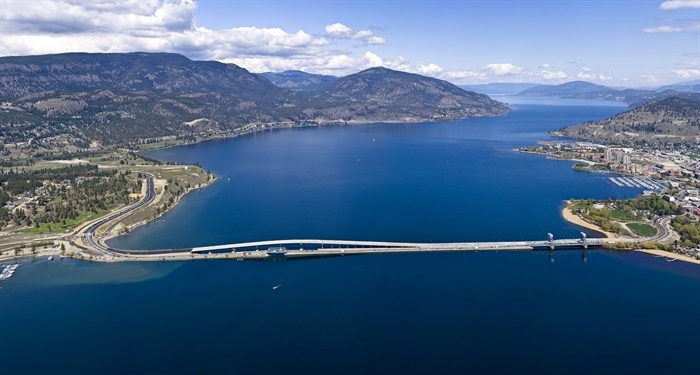
Image Credit: Partnerships BC
July 22, 2019 - 4:45 PM
You might not realize it, but when you travel from Kelowna to West Kelowna along the William R. Bennett bridge, you’re doing something absolutely unique in Canada — travelling on a floating bridge.
It’s also fairly rare across the world — fewer than two dozen pontoon bridges have been built, although Washington State has five.
It’s more complicated than a typical bridge — and more expensive — but distinctive local geology demands it.
In 1958, the first floating bridge in the Okanagan cost $7.5 million. The William R. Bennett bridge replaced it in 2008 for $144 million dollars.
READ MORE: Bennett bridge far ahead of capacity, way behind in planning for second crossing
Although there’s 50 years between designs of the two bridges, there’s one feature that stayed the same: both bridges float. As local geologist Murray Roed explains in his 2014 book Okanagan Geology and in interviews, it all comes down to the composition of the lake bottom.
Initially, designers created plans for a suspension bridge but that was ruled out when they found very soft sediments on the bottom of the lake. That means there's no suitable ground for bridge abutments to be practically and economically constructed.
Even if it were attempted, there would be a huge risk if an earthquake ever hit or impacted the area. Shaking the unstable material could cause liquefaction which could literally pull the ground out from under it.
The lake bottom could not support a rock causeway either. So, designers turned to a floating bridge.
The Okanagan Floating bridge was the first of its kind in Canada and the William R. Bennett Bridge, named after a former B.C. Premier from the region, remains the only Canadian floating bridge today.
Although the technology is generally the same between the original bridge and our current model, there were some major improvements. The original bridge included a lift span near its eastern end to allow boats to travel underneath. However, this posed a major inconvenience to commuters who had to wait any time a boat needed to pass through. The new bridge not only rises high enough for boats to pass underneath but increased to five lanes, two eastbound and three westbound to accommodate the significant population growth that took place since the first bridge was built in 1958.
READ MORE: How Kelowna's Okanagan Lake bridge stays afloat
The William R Bennett bridge consists of nine reinforced concrete pontoons, each of which is 25 meters wide and 30 to 90 meters in length. The floating section of the bridge spans 730 meters.
Essentially, it all comes down to the pontoons, the floating objects used to support floating bridges. On the William R. Bennett Bridge, the six pontoons are interconnected along the length of the bridge and fixed at each end. High-strength steel cables and concrete anchors embedded deep within the lake bottom are used to secure the pontoons and level out the bridge. When the water level rises, the pontoons rise with it, maintaining the horizontal alignment of the bridge.
It's also among the ten longest floating bridges in the world, typically only used in areas where water is particularly deep like Okanagan Lake and where similar soft sediment impedes the construction of bridge piers.
The Bennett bridge was one of only nine of its kind in the world, as stated in a news release from the Ministry of Transportation and Infrastructure. At the time of its opening in 2008, the uniqueness of the bridge didn't go unnoticed.
“The technical features of this bridge have people around the globe watching it on the Internet with our construction camera,” Kelowna-Lake Country MLA Al Horning said at the time. “It is a true feat – one of which we are very proud.”
— This story was first published in July 2019.
To contact a reporter for this story, email Brie Welton or call (250) 801-9235 or email the editor. You can also submit photos, videos or news tips to the newsroom and be entered to win a monthly prize draw.
We welcome your comments and opinions on our stories but play nice. We won't censor or delete comments unless they contain off-topic statements or links, unnecessary vulgarity, false facts, spam or obviously fake profiles. If you have any concerns about what you see in comments, email the editor in the link above.
News from © iNFOnews, 2019